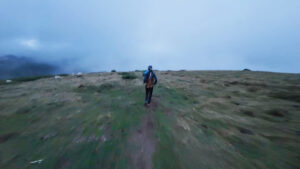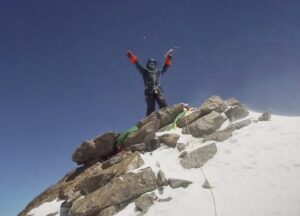The following is a little add-on to last week’s Weekend Warm-Up about Link Sar.
In 2019, alpinists Mark Richey, Steve Swenson, Chris Wright, and Graham Zimmerman notched the first ascent of Link Sar’s Southeast Face (7,041m) in the Karakorum.
Their alpine-style ascent earned the four elite climbers the prestigious Piolet d’Or. Link Sar posed a perilous, high-altitude, multi-year project. Bagging the unclimbed Southeast Face required patience, persistence, and guidance from a few Himalayan ibex. (We’ll get there.)
The expedition pit the quartet of mountaineers against three solid months in the Karakorum — long even by high-alpine standards. But the road to the team’s first ascent was far longer.
The 20-year road to Link Sar

Photo: Graham Zimmerman
It began almost 20 years earlier, when a young Jimmy Chin shared photos of a monstrous, far-off peak in Pakistan’s Kondus Valley with fellow mountaineer Steve Swenson.
Swenson made his first attempt on Link Sar’s southeast face in 2001. “We didn’t have the time or resources to get much higher than about 5,200m, but this route seemed promising, and we planned to return,” he recalled in the American Alpine Journal.
Soon after Swenson returned to the U.S., escalating tensions between Pakistan and India prompted Pakistan to close the Kondus region to climbing. “I applied for and was denied a Link Sar permit in 2004, 2005, 2006, and 2007,” said Swenson.
In an essay for Alpinist, Zimmerman wrote: “The southeast wall of Link Sar stuck in Steve’s mind as a riddle to solve. Near the end of the [2001] expedition, he scrambled up a different approach to the wall…through lower bluffs and ibex pastures. Just below the steepest part of the Southeast Face, he studied the convoluted ridges, hanging ice and intricate buttresses…
“In 2015, he observed the same features again from Changi Tower, and he thought that he could see a passage to the summit.”

Himalayan ibex, natural routefinders in the Greater Ranges. Photo: Shutterstock
Follow the ibex…
Zimmerman was with Swenson on the Changi Tower in 2015 and became similarly enamored with Link Sar’s potential. So in 2017, Swenson, Zimmerman, and Chris Wright arrived at the Southeast Face. The trio spent two months attempting to complete what Swenson started in 2001.
[Zimmerman, AAJ]: “We clambered up ridges that wound to nowhere or ended in slopes under the threat of serac walls. We spotted a small glacier on the north side of the main ridgeline that seemed to bypass all these difficulties, but we couldn’t see a way to get over the ridge and down onto the glacier.”
The three men resigned from the push, retreating to Advanced Base Camp. And this is where the ibex come in.
“We noticed that an ibex herd was crossing this complex ridge system, so we followed their tracks over ‘Ibex Pass’ and found a way onto the little glacier and up to the site of Camp I,” said Zimmerman. “The route we’d discovered was relatively safe from overhead hazard, but intense storms [foiled] us again and again, far below the summit…[But] We all knew we’d be coming back.”
And they were right.
Goat and sheep trails are common sights on steep mountainsides, but how often do alpine animals give mountaineers the key to a route?






